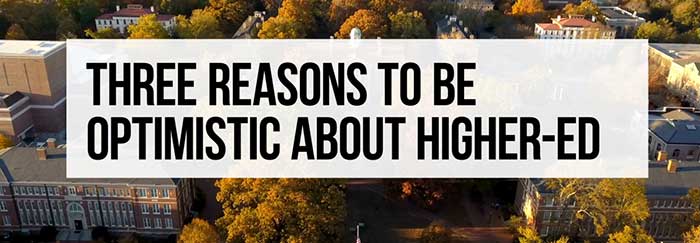
For all who care about higher ed, it’s hard to imagine a worse set of health and economic challenges than what we face today. But there’s also room for optimism about how we might emerge with an education system that serves everyone better. Here are the three rays of hope – call them opportunities, maybe – that I see amid the gloom.
First, some brief background: Before joining Lumina, I was senior vice president for finance and administration at DePauw University, a small liberal arts school in Greencastle, Indiana. There, and before that at Rose-Hulman Institute of Technology in Terre Haute, I dealt with all the familiar challenges facing colleges.
Of course, those issues now seem so manageable compared with the pandemic and economic downturn. The already fraying finances of some schools have worsened, posing a threat to the survival of institutions without healthy endowments. And in my house, with three daughters in college, we have watched our schools struggle with issues of health and safety, remote instruction, and maintaining their roles as communities of learning.
Those of us who come from finance see another part of the picture. My background includes roles in change-dependent industries including a multinational consumer products manufacturer that relied on merger and acquisition for growth. I served at a university technology commercialization initiative that relied on innovation to succeed, and at a global accounting and consulting firm that has thrived in the post-consolidation world of public accounting. So, in addition to seeing this from the foundation perspective and the shoes of a parent, I’m seeing all the financial signs of imminent, existential, disruptive change.
We’re overdue for a financial reckoning in higher education that includes consolidation within the college sector and new partnerships among education providers. Behind that dry analysis is the very real cost for staff and faculty likely to see their lives upended.
But while we can’t avoid all the pain, it will help if the sacrifices ahead result in a stronger system that better serves students, families, and the nation. I’m seeing signs that this is possible – even likely – because we’re making progress in these three areas:
- We’re seeing greater use of cost-saving technology.
- There’s a new and determined focus on the value of credentials such as certificates and industry-recognized certifications that can lead to college degrees.
- More of those with the ability to make change happen now recognize that better serving adults and other students – especially people of color who have been left behind historically – will benefit the economy, individuals, and society.
No one has all the answers, but some of them are emerging even as we learn more about the depth of these converging health and economic crises.
There is not a one-size-fits-all solution.
College and university playbooks will be highly customized depending on a host of factors. More than a third of today’s college students are at least 25 years old. More than six of every 10 work, and 40 percent of them work full time. Nearly a quarter of today’s college students have children. And more than half of students live on their own—away from campus and without their parents’ support. Only about one of every five students is a first-time student who entered college full time after high school. So, colleges should plan accordingly.
Many colleges entered the pandemic with fragile finances, and matters will only grow worse.
Most institutions of higher education rely on a handful of revenue sources: tuition and fees, state appropriations, research grants and contracts, and endowment earnings and donations. Each of these revenue sources faces considerable pressure. Also, most colleges are saddled with fixed costs that are difficult to adjust, such as residence halls, classroom buildings, and athletic and other physical facilities. These expenses burden a system that already is weathering a mismatch that has them increasingly educating fewer students than they are set up to handle, further challenging their business models. They’ll enter this academic year in a state of crisis that will force vulnerable schools to close and will leave others scrambling to adapt.
Students and families will not offer colleges much grace.
In fairness, college administrators and faculty leaders have never worked harder to prepare for a new school year. It’s also true that many of these leaders have worked hard for much longer to make sure that students and parents know they are buying an experience—not just a college degree. The experience of in-person instruction can be of great value. But that experience comes with a price tag, and expenses have increased at five times the rate of inflation during the past 35 years. Students’ and parents’ expectations are sky high. Universities cannot—even temporarily—pull that experience back, maintain their pricing, and expect to avoid serious backlash.
Technology has evolved.
Just five years ago, the digital infrastructure in education would have been insufficient for a successful fall 2020 online. However, technology is evolving rapidly, and even the current disruption has spawned a new era of tech tools. Tech-enabled mentoring programs that help students finish on time, online platforms that expertly deliver content from world-class faculty members, and a newer breed of course-sharing solutions are now available to serve college students.
That’s the good news. Technology must—and it will—play a larger role on and off college campuses. There is room for optimism if colleges commit to real improvement in the learning opportunities they offer, can demonstrate real value to students and parents and carry an innovative and open mindset related to meeting the demand that will exist for the right offering. The higher education system has been in need of change for some time. Now, we stand at the doorstep of a learning revolution.
As a father, I see my daughters and their classmates embarking on a genuinely unique opportunity. Yes, there will be challenges. And the path won’t be smooth for some time.
But if higher education leaders and faculty members rise to the challenge, then along with their role as students, my daughters and students of all ages across the country will have another role—that of pioneers in a profoundly exciting period of exploration, one that could lead to a learning system that better serves everyone, rich and poor alike.
Brad Kelsheimer is vice president for finance and investments and chief financial officer at Lumina Foundation, an independent, private foundation in Indianapolis that is committed to making opportunities for learning beyond high school available to all.
